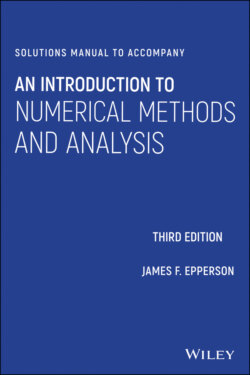Читать книгу Solutions Manual to Accompany An Introduction to Numerical Methods and Analysis - James F. Epperson - Страница 7
1.2 ERROR, APPROXIMATE EQUALITY, AND ASYMPTOTIC ORDER NOTATION Exercises:
Оглавление1. Use Taylor's Theorem to show that for sufficiently small.
1 2. Use Taylor's Theorem to show that for sufficiently small.Solution: We can expand the cosine in a Taylor series asIf we substitute this into and simplify, we getso that we havewhere . Therefore, .
2 3. Use Taylor's Theorem to show thatfor sufficiently small.Solution:We have, from Taylor's Theorem, with ,for some between 0 and . Sincefor all sufficiently small, the result follows. For example, we havefor all .
3 4. Use Taylor's Theorem to show thatfor sufficiently small.Solution:This time, Taylor's Theorem gives us thatfor some between 0 and . Thus, for all such that ,where .
4 5. Show that
5 6. Recall the summation formulaUse this to prove thatHint: What is the definition of the notation?
6 7. Use the above result to show that 10 terms () are all that is needed to computeto within absolute accuracy.Solution:The remainder in the 9 term partial sum is
7 8. Recall the summation formulaUse this to show that
8 9. State and prove the version of Theorem 1.7 which deals with relationships of the form .Solution: The theorem statement might be something like the following:Theorem: Let and , with for all sufficiently large. ThenIn the last equation, is an arbitrary constant, independent of .The proof parallels the one in the text almost perfectly, and so is omitted.
9 10. Use the definition of to show that if , then .
10 11. Show that if and , then .Solution: We haveandThese follow from the definition of the notation. Therefore,which implies that .
11 12. Suppose that and , for sufficiently small. Does it follow that (for sufficiently small)?
12 13. Show thatfor all sufficiently small. Hint: Expand out to the fourth order terms.Solution:This is a straight‐forward manipulation with the Taylor expansionsandAdd the two expansions to getNow solve for .
13 14. Explain, in your own words, why it is necessary that the constant in (1.8) be independent of .
